11 September 2016
A Draw in the Style of Pervakov
Round Six of the Baku Olympiad in the review of Vladimir Barsky.
During the rest day all Russian delegation members headed as one out of the city towards clear waters and soft sand, where in the early 1980s the young Garry Kasparov was building himself up to storm the Olympus. A vivid picture of our team’s recreation time was painted by the RCF PR-director Kirill Zangalis, a unique person who has managed to turn the Sport-Express into a wall newspaper of the Russian Chess Federation. We were joined by the legendary photographer Boris Dolmatovsky, who never lets go of his camera even when devouring dolma with Luleh kebabs and washing down these delicious dishes with the Baku black thyme tea. Below you will find a photo gallery by Boris Georgievich about this wonderful tour that added so much energy and high spirits to our grandmasters.
In round six an ordeal was in store for our girls in the form of a key matchup against Ukraine. Sharing his view of the events is the team captain grandmaster Sergey Rublevsky:
– We got on the wrong foot with the match opening as it went quite contrary to what we had planned, to put it mildly. Only Olga was a ray of light in the realm of darkness, pressurizing right from the opening and it feels as though should have won much earlier than she did. In the other three games, however, our positions were virtually falling apart by as early as by move fifteen. It was all wrong, heading towards the direction it should not! This said, the quality of the game was so low that it defies any commenting.
And then, as is often the case, miracles would start taking place. Zhukova, playing against Sasha Goryachkina, blundered a tactical blow on d4, upon which the situation balanced out.
Zhukova – Goryachkina
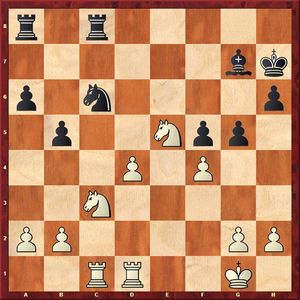
In lieu of 27. g3, keeping an extra pawn and all benefits of his position, White hurried to force the events:
27. Nd5? Nxd4! 28. Rxc8 Rxc8 29. Rxd4 gxf4 30. Nxf4
White is unable to get two minor pieces for a rook: 30. Nf3 Bxd4+ 31. Nxd4 Rd8 32. Nf6+ Kg6.
30... Bxe5 31. Rd7+ Kg8 32. Nd3 Bg7 33. Rd6 Rc2 34. Rxa6 Rd2 35. Ra3 Bxb2 36. Nxb2 Rxb2 37. Ra7 Draw.
Despite Sasha Kosteniuk’s stubborn resistance, the opposing forces were too unequal. Having blundered 20.е5, Black ended up being down two pawns in a bad position. As for Valentina, she escaped by miracle.
– What was happening on Valentina’s board anyway? It looks like some kind of a merry-go-round that resists any comprehension.
– It is difficult for me to say anything definite also. Maria Muzychuk was perhaps greedy with 30...Rf7. Valentina was not going to take the exchange anyway since Black has way too many pawns for it. It all ended up as if taken from one of Oleg Pervakov’s studies: White delivered a perpetual with all Black pieces blocked out of play! When it happened White had only one pawn remaining on the board!
Gunina – M. Muzychuk
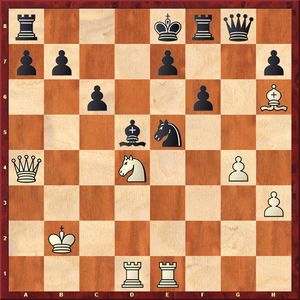
30…Rf7 31. g5 Qg6 32. Ka1 Nd3 33. Re6Nc5 34. Qb4 Nxe6 35. Qxb7 Rd8 36. Nxe6 Bxe6 37. Qxc6+ Bd7
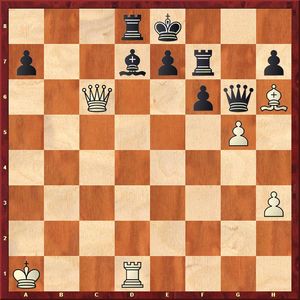
38. Rxd7! Rxd7 39. Qc8+ Rd8 40. Qc6+ Rd7 41. Qc8+ Draw.
Meanwhile, Olga, who was conducting her game in a brilliant manner, had it all screwed up on move 40 by blundering the d4-pawn, upon which the position became approximately equal. Olga was altogether blind to her opponent’s possibility of capturing this pawn, counting only on 40...Qxe6+ 41.d5, and White wins. Virtually any other move was winning instead. Fortunately for us, Ushenina did not get deep enough into the position and wasted several tempi so that following the white rook’s transfer onto b3 Black’s position became unpleasant again with her exposed king in the center. In the new time trouble Olga finally broke through Black’s defenses.
Girya – Ushenina
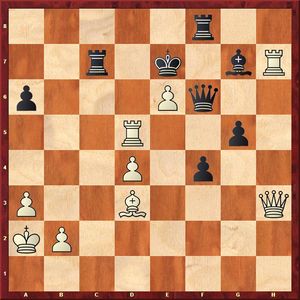
40. Rf5? Qxd4 41. Qg2 Rxf5 42. Bxf5 Qf6
Black is OK, for example, after 42... Qc4+ 43. Ka1 Kd6.
43. Bg4 Qe5 44. Rh3 Qb5 45. Rb3 Qc4 46. Be2 Qxe6 47. Qxg5+ Bf6 48. Qh5 Bg7 49. Bf3 Qe5 50. Qg6 Qf6 51. Qh7 a5
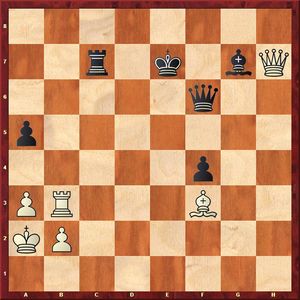
52. Rb5 a4 53. Bd5 Rd7 54. Qe4+ Kd8 55. Qxa4 Qd4 56. Qa8+ Ke7 57. Qg8 Qf6 58. Rb8 Bf8 59. Bc4 Rc7 60. Qd5 Rd7 61. Qe4+ Kd6 62. Rb6+ Black resigns.
– How do you cope with such stresses?
– I have no recipe for that.
– Team captains are no longer allowed reading books in the play area. And what can he do to keep himself busy?
– He can serve tea. Reading books is prohibited – they do not give you a chance to pretend smart. This is likely to be a reasonable measure, but a sad one anyway. There is nothing to occupy yourself with, especially during the first three hours.
– Do you like the playing conditions?
– They are fabulous! There is a lot of free space, plenty of room in between the adjacent match tables, and there is no need to drive spectators out. What does a captain attend to most of the times? Someone would invariably come too close to the table to watch the game, squeezing in between the players, who feel it no longer comfortable to go on playing normally. There is at least twice as much free space for each match as used to be in Reykjavik at the European Championship or at the Olympiad in Tromsø. However, the playing conditions in Tromsø, frankly speaking, are best forgotten forever.
Our men’s team opponent, the German team, is, of course, strong and solid, but not classified as on of the giants. All jokes aside, Andrey Filatov and his aides managed to “rock” Vladimir Kramnik so that he went on to play a brilliant game. The 14th World Champion shared his impressions with the RCF website audience.
Kramnik – Meier
French Defence
– At the second attempt, involving the sacrifice of two pieces, I finally managed to score a victory in this line! I have come up with an new interesting idea of a3, dxc5 and Qf2. Nowadays the а6 and Be7 plan is extremely popular, every member of the German team employ it on a regular basis. This line gives rise to complex positions.
1. e4 e6 2. d4 d5 3. Nc3 Nf6 4. e5 Nfd7 5. f4 c5 6. Nf3 Nc6 7. Be3 a6 8. Qd2 Be7 9. a3 0-0 10. dxc5 Nxc5 11. Qf2 b6 12. b4 Nd7 13. Bd3 f6 14. Qg3 d4
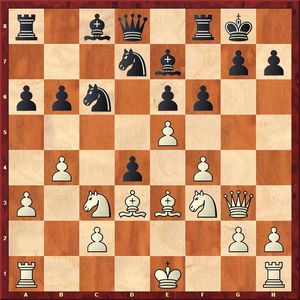
15. 0-0-0
Somehow, I did not expect the 11…b6 12.b4 Nd7 response and have not analyzed it for that reason. Therefore, I had to find my way over the board. This position is difficult to get to the bottom of during the game. Following the end of the game I looked it up for a computer tip: the engine claims that 14...d4 is best answered by 15.Bxd4 Nxd4 16.Nxd4 Nxe5 17.0-0-0 Nxd3+ 18.Rxd3 with a substantial edge for White, but from a human point of view this position looks quite obscure because of my exposed king. This line is extremely difficult to go for unless you happen to be conversant with a computer evaluation. I calculated the consequences of a piece sacrifice and it seemed very promising to me. I won a piece back later. It is clear that White builds up pressure, but the position is very complex and a great deal of further analysis is required.
15... dxe3 16. Bxh7+ Kxh7 17. Qh3+
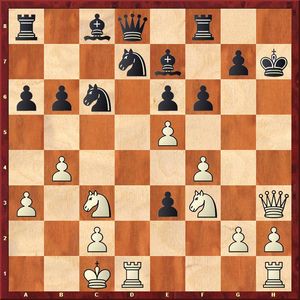
17…Kg8
17... Kg6 is very strongly met by 18. f5+! with the following indicative lines: 18…exf5 (18... Kf7 19. fxe6+ Kg8 20. exd7 Bb7 21. Qe6+ Rf7 22. exf6 Bxf6 23. Nd5) 19. Nh4+
1) 19... Kf7 20. e6+ Kxe6 (20... Ke8 21. Nxf5) 21. Qxf5+ Kf7 22. Qg6+ Kg8 23. Nf5 Rf7 24. Nh6+;
2) 19…Kh7 20. Nxf5+ Kg8 21. Qg4 g5 22. Qc4+ Kh8 23. Qxc6.
18. Qxe6+ Kh8 19. Qxc6 Ra7 20. Nh4 Qe8 21. Nd5 Kh7 22. Nxe7 Qxe7 23. Nf5
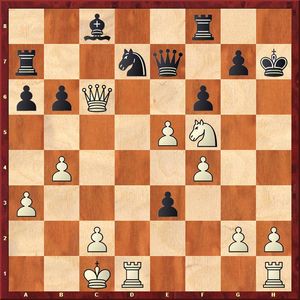
23…Nxe5
The computer evaluates that Black was keeping his position together after 23...Qe8 24. Nd6 Qe6 or 24. e6 Nb8, but humanwise it feels risky to allow the knight’s landing on d6. However, this is the way he should have played because the endgame which Black transposed into is, of course, with drawing chances, although it is an unpleasant struggle uphill. Besides, Meier was pressed for time. I think the only chance lay in Black’s somehow defending his e3-pawn by some tactical means. However, after this pawn was traded for my g2-pawn, I believe my strong d4-knight turned my position into a technically winning one.
24. Nxe7 Nxc6 25. Nxc6 Rc7 26. Nd4 Re8 27. Rd3 Bb7 28. Re1 Bxg2 29. Rdxe3 Rxe3 30. Rxe3 Bd5
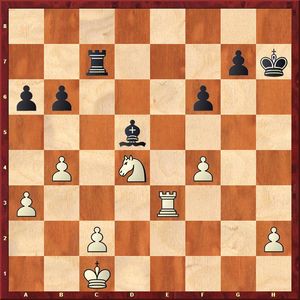
31. Nf5!
As I said, Black was under severe time pressure and after this move he failed to keep his position together in view of some concrete lines.
31…g5 32. fxg5 fxg5 33. Re5 Bf7 34. Kb2 b5 35. Nd4 Kg6 36. Nf3 g4 37. Rg5+ Kf6 38. Rxg4 Black resigns. A very exciting and complex game, which should be subjected to a detailed analysis though.
– Vladimir, do you like the way the Olympiad is organized?
– Yes, everything is well on track in Baku. The Olympiad is always a demanding competition with a greater share of responsibility compared to individual tournaments. Besides, there is little time for preparation as this event has a forced nature. It is only natural that you get tired. This is a challenging tournament, but an interesting one at that. We suffered a silliest defeat from the Ukraine, an absolute helpmate. Fortunately, nevertheless, we were able to get back in the fight for top places. We should try hard because decisive matches are coming our way. Yesterday we had a great time together. It is a pity that there is only one rest day here - I would gladly visit this recreation facility again!
The Russian men’s team ended up defeating Germany with a 3-1 score. Sergey Karjakin and Evgeny Tomashevsky confidently drew with the black pieces, while yet another victory was scored by Ian Nepomniachtchi. It seems as though he got no advantage out of the opening and there remained almost no pieces on the board, but Ian still succeeded in outsmarting such an experienced and solid player as Daniel Friedman. How Ian manages to pull it off is a mystery, but the most important thing is that this mystery defies unravelling by his opponents either. Nepomniachtchi has scored six wins in six games - kudos!
The central match of the round, India - Netherlands, had three games that ended in draws, while the fate of the match was sealed by a one-move blow on board two.
L’Ami – Adhiban
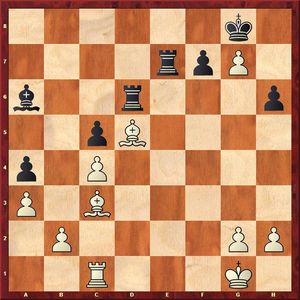
White has two pawns for the exchange, his bishops are very powerful, which makes the position approximately equal. It is, of course, desirable to place the c1-rook into a more active square, but where to? The e1-square is not an option since the g7-pawn is lost after the exchanges, whereas 36. Rf1 was very likely turned down by Erwin in view of 36…Rxd5! White made up his mind to contest another open file, setting a small trap along the way – 36. Rd1?
Taking on f7 threat is in the air, but Black pays it no heed.
36... Bxc4!
It turns out that 37. Bxf7+ is not a threat because of 37…Rxf7 38. Rxd6 Rf1#. Following 37. Bf3 Rxd1+ 38. Bxd1 Bb5 Black gradually overran the opponent’s defenses. India prevailed with a 2.5-1.5 and is clear first at the moment.
We continue acquainting our readers with feedback of famous grandmasters on the Olympiad:
Rauf Mamedov (Azerbaijan):
– I can say for myself that I feel no pressure at all when playing on home soil. On the contrary, it provides good motivation. This is my seventh Olympiad. I have always wanted an Olympiad to be held in Azerbaijan. When playing on home soil, we receive incredible support. I am happy to play at home. Besides, the level of the Olympiad is very high. Teams stay in the best hotels. I have not seen anything like that elsewhere.
Pictures by Boris Dolmatovsky and Vladimir Barsky






















